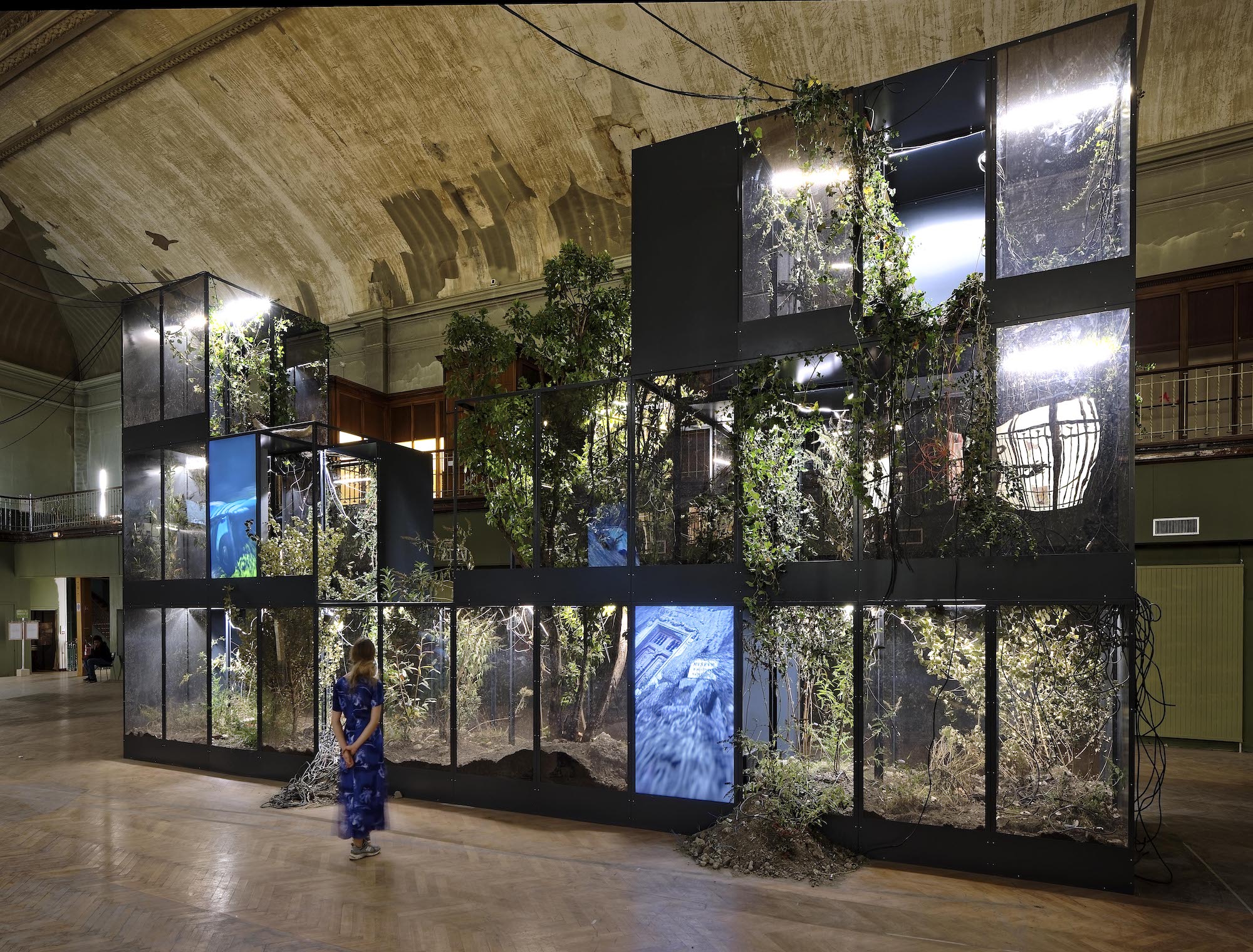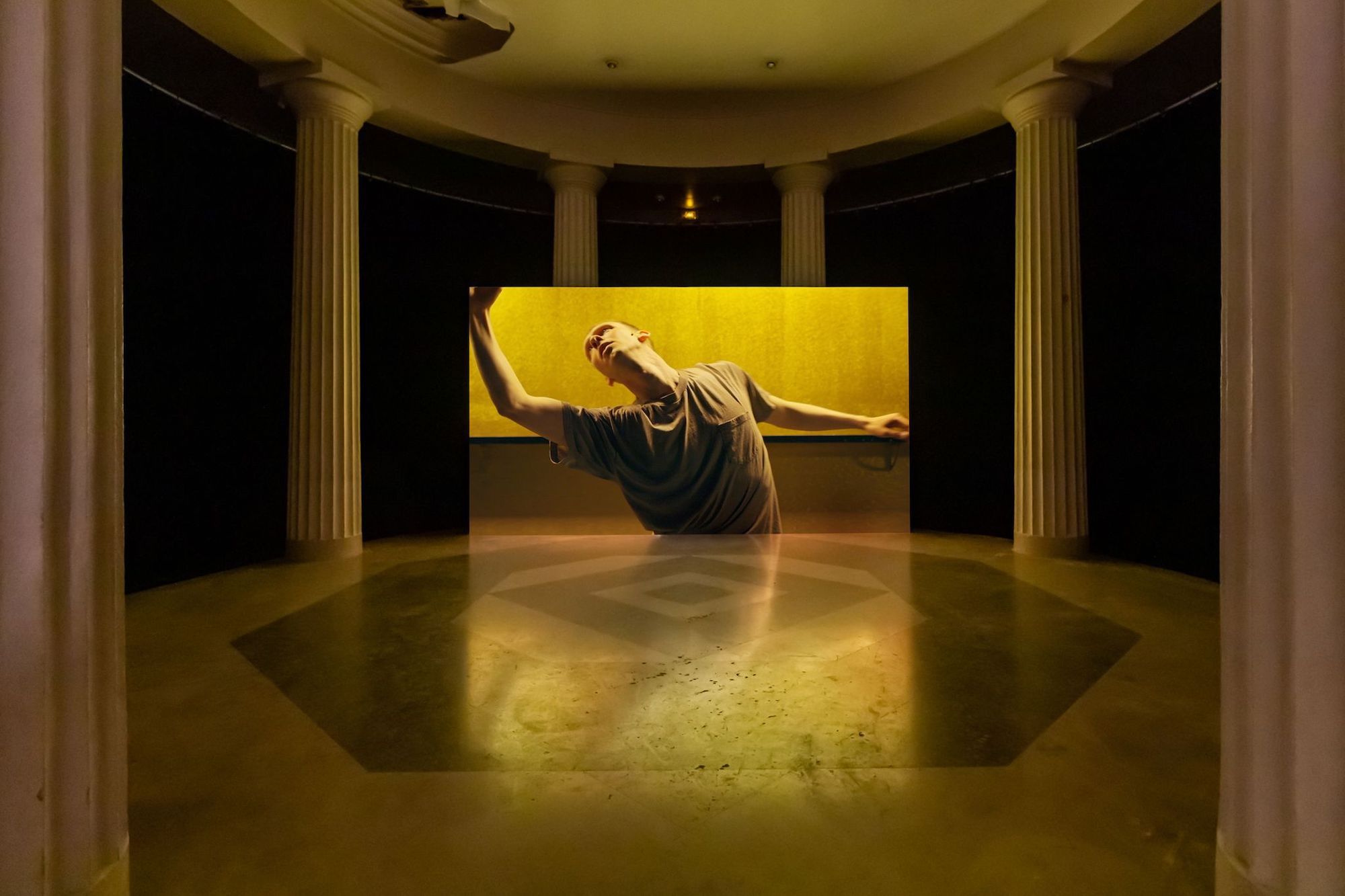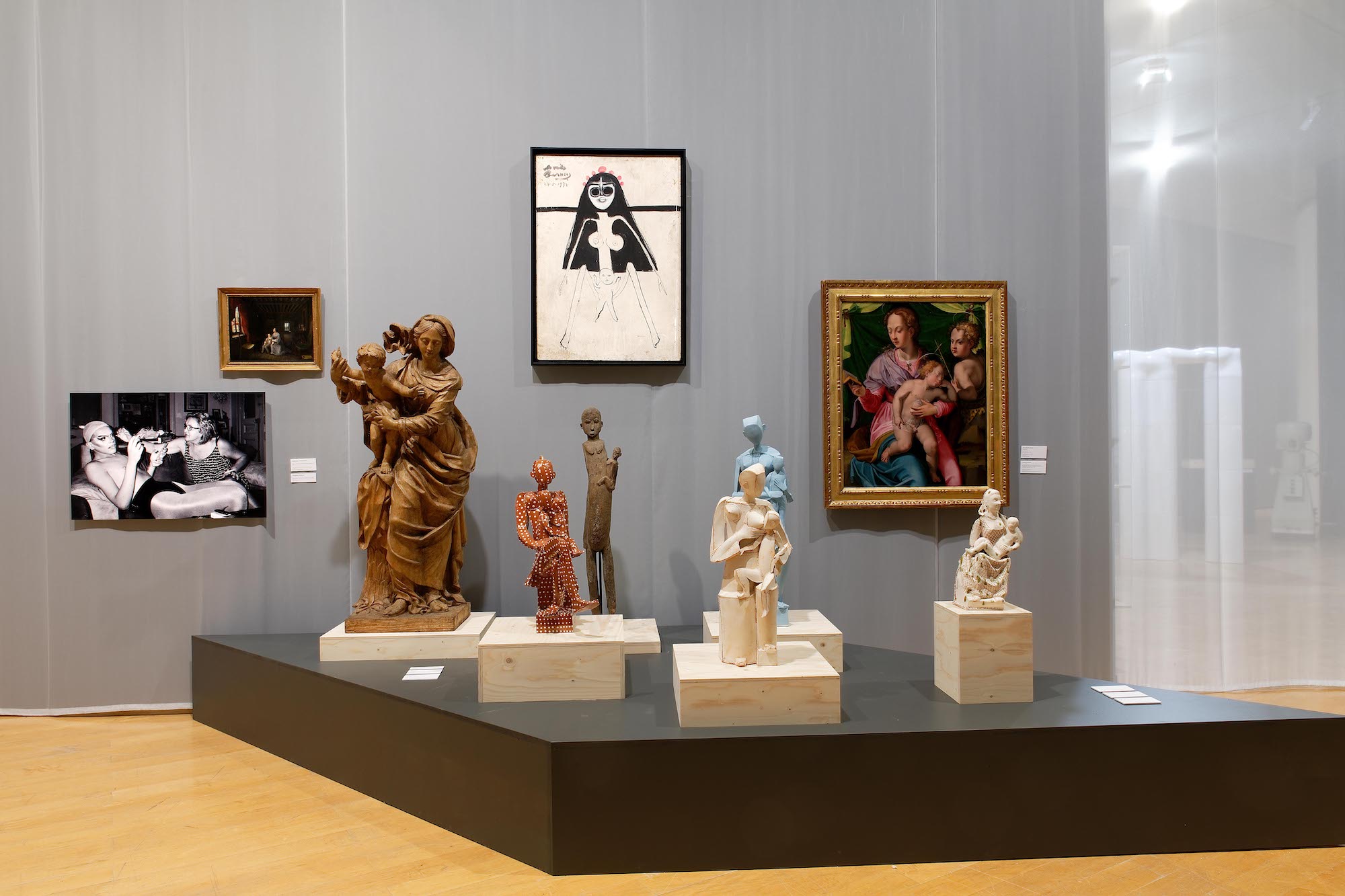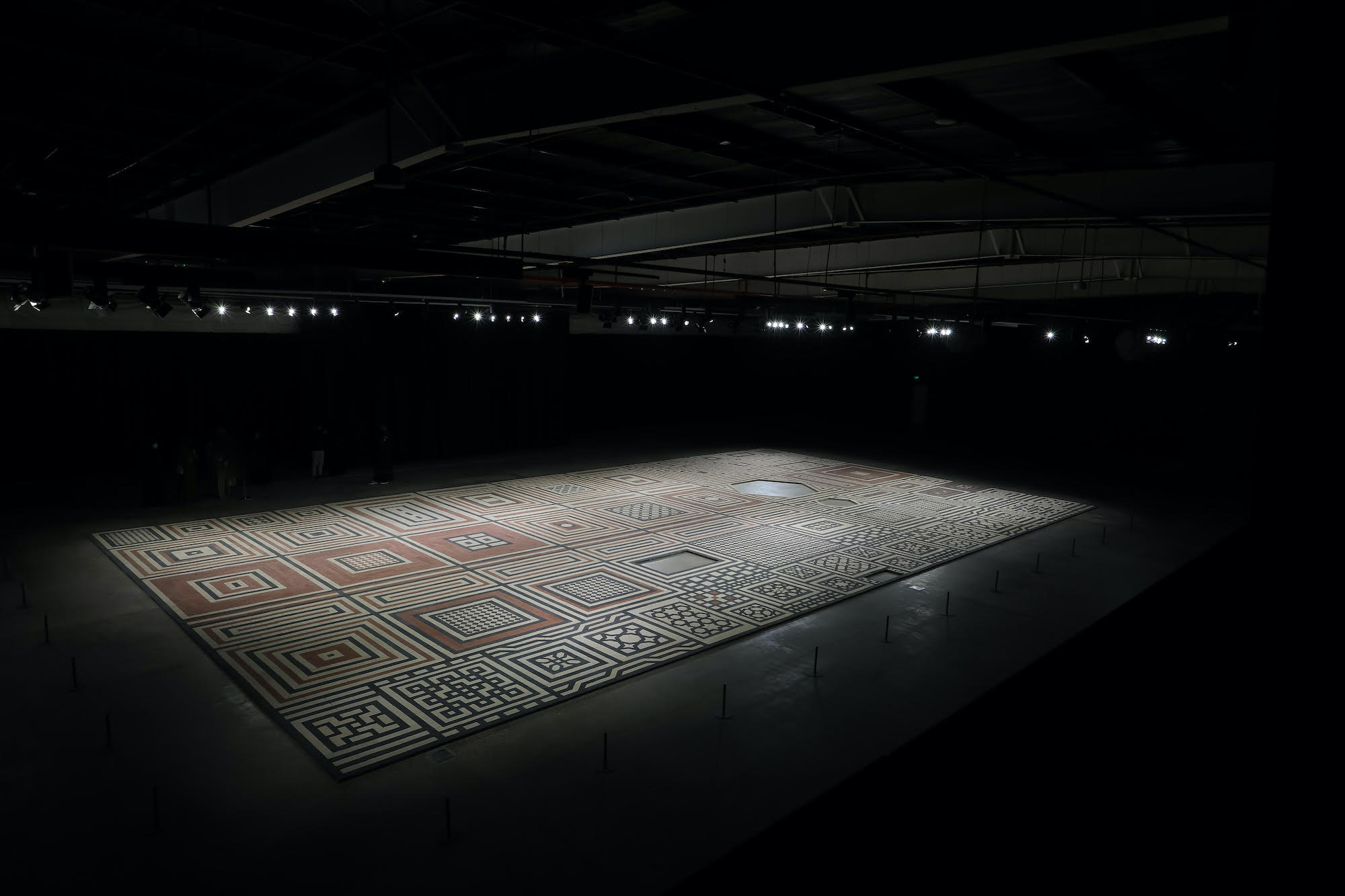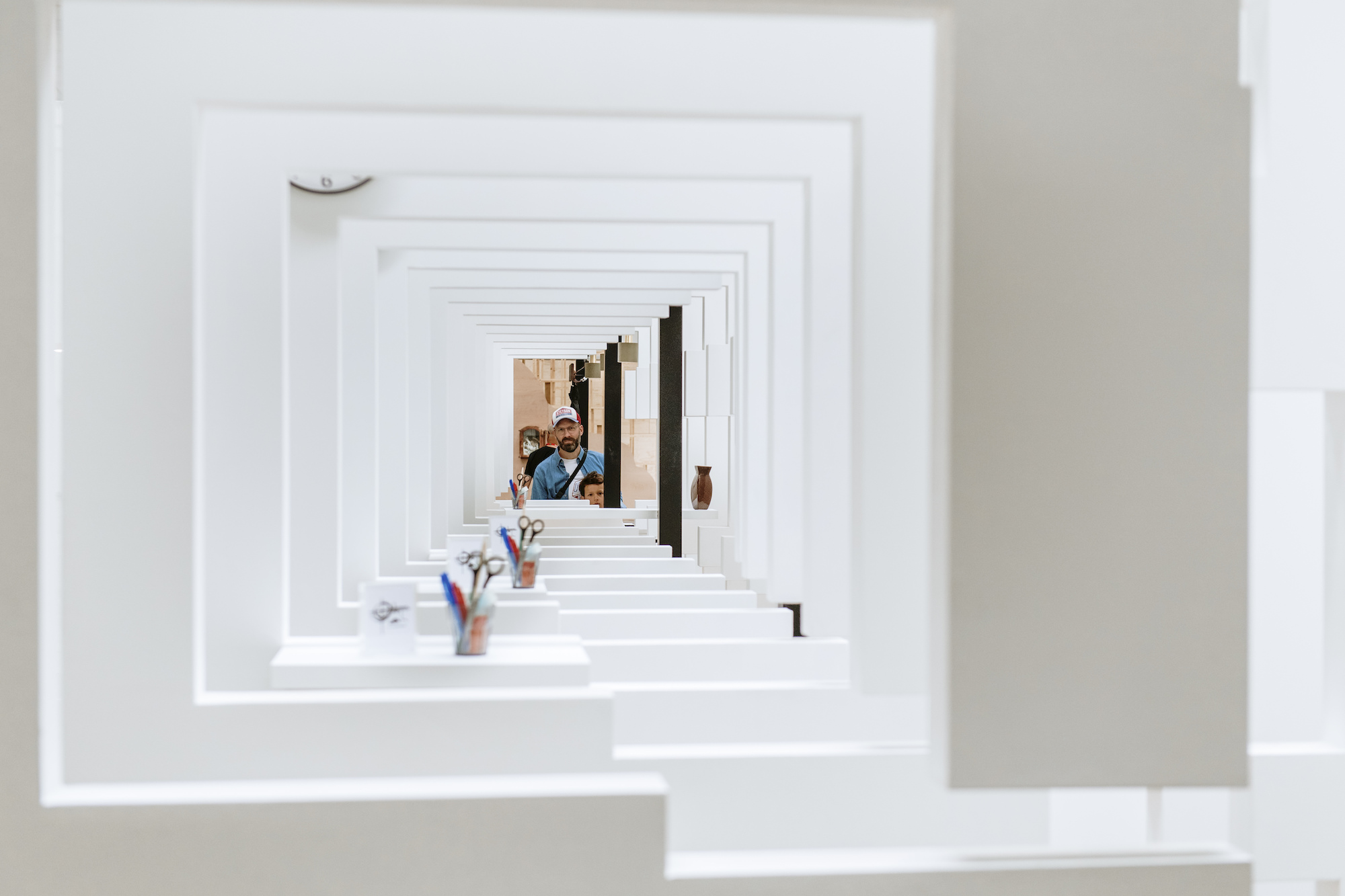The 16th Lyon Biennale: manifesto of fragility
Hans Op de Beeck, We Were the Last to Stay, 2022, installation of various materials [courtesy of the artist and 16th Lyon Biennale “manifesto of fragility”]
Share:
It may have been a mistake to start my walk through the 16th Lyon Biennale at its main exhibition space and largest venue, Usines Fagor. Measuring 29,000 square meters, this former factory seems better suited to the other cultural events it hosts, such as the Nuits Sonores electronic music festival and Lyon Street Food Festival, given the soundstage design and rote booth format each requires respectively. But for a biennale exhibition of contemporary art, the location felt too large to handle, which resulted in a thematic collapse that was thankfully recovered by the rich offerings within the Biennale’s 11 other venues.
Take Musée Guimet, built in the 19th century to house a collection of Asian art and antiquities that was soon transferred to Paris. Holding court in the main exhibition hall was Ugo Schiavi’s Grafted Memory System (2022), a “techno-organic ecosystem” composed of stacked steel cabinets, lit with horticultural LEDs that illuminated vegetation, fossils, and bones. CGI videos showing uncanny views of the ecosystem played on screens that covered the surface spaces of some cabinets. A mezzanine floor wrapping around the hall framed Schiavi’s monumental installation, with wooden vitrines that evoked the museum’s transformation into a natural history museum in 1913, thus perfectly integrating works into their enigmatic setting. Among them, graphite pencil drawings on felt by Zhang Yunyao, each zooming in on a suggestive, fleshy detail including a close-up of two points in a diamond-tufted upholstered surface, and dimples of Venus carved into the lower back of a Greco-Roman sculpture.
Ugo Schiavi, Grafted Memory System, 2022, Steel installation, plants, insects, computer-generated videos, fossils, bones, electric cables, horticultural LEDs, sound 38 [courtesy of the artist and 16th Lyon Biennale “manifesto of fragility”]
Elsewhere in the museum, Wish You a Lovely Sunday (2021), a film by Young-jun Tak, depicted the outcome of Tak’s invitation to two choreographer and dancer pairs. Each was prompted to develop choreography for a different Berlin venue—the Kirche am Südstern church and SchwuZ queer club—according to one of Bach’s four-hand piano compositions, only for their designated locations to be swapped on the day of filming. The result is a sensuous amplification of place that’s heightened by people working with their displacement—an effect echoed in manifesto of fragility’s exhibition venues, each sensitively chosen by curators Sam Bardaouil and Till Fellrath to anchor their expansive and often dislocating curatorial gesture to Lyon itself. Musée Guimet, for instance, which had been closed since 2007, survived its initial abandonment in the 19th century by transforming into a brasserie, a theater, and a skating rink—a shapeshifting that extended to manifesto of fragility’s curatorial framework, which was articulated most sharply at macLYON.
Young-jun Tak, Wish You a Lovely Sunday, 2021, Single-channel HD video, color, 5-channel sound, 18:38 [courtesy of the artist and 16th Lyon Biennale “manifesto of fragility”]
Here, ancient artifacts were presented alongside modern and contemporary artworks to express the Biennale’s thematic spine: “The Many Lives and Deaths of Louise Brunet.” Imprisoned in Lyon as a young woman for taking part in the 1834 uprising by Lyon’s silk-weavers, Brunet later landed in Beirut at the end of that decade. In Lebanon, she worked in a French silk factory before her imprisonment there for fomenting revolt. While creating a contextual link between the two cities, notably through the 19th-century silk trade and establishment of the French mandate in 1920, Brunet’s story also speaks to the enduring struggle the curators describe in their exhibition text: of people “seeking to liberate themselves from the circumstances into which they were born.”
An impressively succinct weaving of temporalities honored and challenged that sense of liberation at macLYON, most notably with an 18th-century French Revolutionary freedom bonnet that problematized a 19th-century painting showing the entry of the French army into Beirut (suggesting instances of French colonial violence enacted under the guise of a revolutionary republic). Other works on display ranged from a 5th/6th century Egyptian stele depicting Joseph to a 16th-century portrait of the cross-dressing French king Henri III. This painting was hung in proximity to Gabriel Arantes’ 16mm film A History of Princess X (2016), which reads Brancusi’s eponymous phallic sculpture as one evoking gender fluidity rather than certainty. The effect was a collapse of boundaries that queered (read: liberated) everything. As indicated in one section of the macLYON show, where historical depictions of madonna and child were installed alongside such contemporary works as Mohamed Abdouni’s 2019 black-and-white photograph of Doris, a mother in Beirut, doting on her genderqueer child, Andrea.
16th Lyon Biennale “manifesto of fragility”, installation view, 2022 [courtesy of 16th Lyon Biennale “manifesto of fragility”]
Moments like these, where the show drilled down on its complex resistance to heteronormativity (and thus paternalism), heightened the breakdown at Usines Fagor, with its abundance of large-scale installations that, while meaningful—as with Dana Awartani’s Standing by the Ruins of Aleppo (2021), a clay brick reproduction of the courtyard floor in Aleppo’s Grand Mosque—hinted at a curatorial anxiety to fill the site’s cavernous spaces. Scale is a big issue with biennales these days, in the face of economic, ecological, and political recession and regression—a condition that the inclusion of Joana Hadjithomas and Khalil Joreige’s Where Is My Mind? (2020) seemed to intentionally confront. On a 12-meter-wide screen, images of headless ancient statues pass in and out of view, as trails of digital zeroes and ones cascade around them. At times, ancient heads isolated against magenta grounds multiply to form patterned grids that then distill into pure color blocks, which point to the conditions the work addresses. “This mysterious parade of heroines or fallen heroes who have lost their singularity,” the artists state, “questions our identity at a time when we feel we are increasingly falling more captive to data and codes that could endanger our propensity to act and dream freely.”
Dana Awartani, Standing by the Ruins of Aleppo, 2021, clay earth, 896 x 512 inches [courtesy of courtesy of Canvas and Diriyah Biennale Foundation]
The unease of scale, then, and its ability to flatten and erase, were infused into the Usines Fagor’s curatorial address and amplified by its over-reach: a fragile maximalism that touches upon the politics of attention holding sway over the globalized art world’s political and financial economy. Take Hans Op de Beeck’s We Were the Last to Stay (2022), a post-apocalyptic campsite flocked in gray coating suggesting the aftermath of a cataclysm. The scene luxuriates in its own warehouse: the scaling up of a one-trick aesthetic that, despite amplifying a message of impending doom with crowd-pleasing clarity, has been rolled out at more than one art fair to guarantee Instagram exposure and placement in a clickbait listicle. This observation is not a criticism of the work so much as a recognition of the increasing need, across the so-called art world, to quantify its public reach, whether the pressure for institutions to deliver respectable visitor counts or the race to conquer Google’s search engine optimization by online art platforms producing content that privileges searchable keywords (not to mention blue-chip artists and galleries).
It can all feel like a Sisyphean wasteland, which is how the Usines Fagor came off, with its gargantuan halls, rough-shod divisions, and bombasticism—a special kind of purgatory that found form in Pedro Gómez Egaña’s Virgo (2022). Here, the furnishings of a deconstructed apartment interior are connected to a steel armature that a performer pulls and pushes so the fragmented objects pass through various voids cut into a line of white frames—a metaphor, perhaps, for a homogenizing mindset that was amplified by a line of 25 white plaster-cast reproductions of ancient sculptures taken from the collection of Lyon’s Musée des Moulages—among them statues of Venus and Athena—positioned in distant parallel to Virgo in the same hall. Encased in scaffolding designed by Olivier Goethals, over which a white PVC-like material was stretched like skin, these facsimiles raised a key inquiry in a show where images of the ancient Greco-Roman world abounded: What fragility is under the microscope?
Pedro Gómez-Egaña, Virgo, 2022, 29 modular walls in metal, wood with cardboard insulation, various objects [courtesy of the artist, Zilberman Gallery and 16th Lyon Biennale “manifesto of fragility”]
An answer arrived in Marta Górnicka’s video of a 2018 performance staged at Berlin’s Brandenburg Gate, where a mix of 50 amateur and professional performers from different backgrounds sang the German constitution. Described as a “choral stress test,” the phrase “All Germans” emerged as the constitution’s most fraught claim. “German society today is deeply divided,” the artist has noted. “Two different visions of community are clashing—national and homogeneous versus open and diverse.” In a world shaped by the after-effects of colonization and the ongoing impact of capitalism, imperialism’s highest form, that dichotomy is manifesting elsewhere. It was underlined by six paintings at Usines Fagor from Mohammed Kazem’s Even the Shade Does Not Belong to Them series (2022), which depicts migrant workers in the UAE, including one scene wherein a crowd lines up to fill an already crammed bus.
Whiteness—that is, the historically systemic tendency within the context of Western modernity to exploit others by treating them as inferior and expendable data points—is both a state of mind and a house of cards, as Frantz Fanon argued decades ago when describing colonized elites. All of which circles back to the curatorial collapse at Usines Fagor, and an overwhelming sense of scale that highlighted the curators’ attempts to position fragility “at the heart of a generative form of resistance.” Increasingly fragile, too, are the conditions in which we are expected to show and see art.
Stephanie Bailey is an Art Papers contributing editor, global editor-at-large for Ocula Magazine, an editor for Art Basel Stories, and conversations curator and content advisor for Art Basel Hong Kong. Formerly the senior editor of Ibraaz, where she worked from 2012–2017, and director of the first BTEC-accredited foundation diploma in art and design in Greece from 2009-2012, Bailey has contributed to Artforum, Art Monthly, Art Review, dɪ’van: A Journal of Accounts, Spike, and Yishu: Journal of Contemporary Chinese Art, among others, and also edits for M+, the museum of visual culture in Hong Kong. She is currently working on a PhD at Birkbeck School of Law, University of London, exploring the historical and contemporary intersections between art and the pursuit of human rights.
